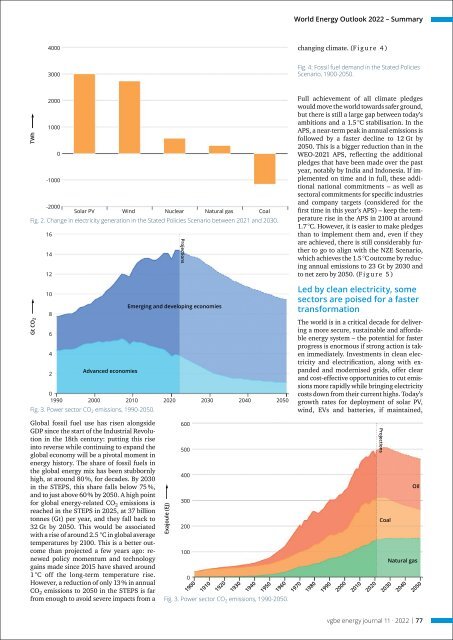vgbe energy journal 11 (2022) - International Journal for Generation and Storage of Electricity and Heat
vgbe energy journal - International Journal for Generation and Storage of Electricity and Heat. Issue 11 (2022). Technical Journal of the vgbe energy e.V. - Energy is us! NOTICE: Please feel free to read this free copy of the vgbe energy journal. This is our temporary contribution to support experience exchange in the energy industry during Corona times. The printed edition, subscription as well as further services are available on our website, www.vgbe.energy +++++++++++++++++++++++++++++++++++++++++++++++++++++++
vgbe energy journal - International Journal for Generation and Storage of Electricity and Heat.
Issue 11 (2022).
Technical Journal of the vgbe energy e.V. - Energy is us!
NOTICE: Please feel free to read this free copy of the vgbe energy journal. This is our temporary contribution to support experience exchange in the energy industry during Corona times. The printed edition, subscription as well as further services are available on our website, www.vgbe.energy
+++++++++++++++++++++++++++++++++++++++++++++++++++++++
- Keine Tags gefunden...
Erfolgreiche ePaper selbst erstellen
Machen Sie aus Ihren PDF Publikationen ein blätterbares Flipbook mit unserer einzigartigen Google optimierten e-Paper Software.
World Energy Outlook <strong>2022</strong> – Summary<br />
4000<br />
changing climate. (F i g u r e 4 )<br />
3000<br />
Fig. 4: Fossil fuel dem<strong>and</strong> in the Stated Policies<br />
Scenario, 1900-2050.<br />
TWh<br />
2000<br />
1000<br />
0<br />
-1000<br />
-2000<br />
Solar PV Wind Nuclear Natural gas Coal<br />
Fig. 2. Change in electricity generation in the Stated Policies Scenario between 2021 <strong>and</strong> 2030.<br />
Gt CO 2<br />
16<br />
14<br />
12<br />
10<br />
8<br />
6<br />
4<br />
2<br />
Advanced economies<br />
Emerging <strong>and</strong> developing economies<br />
0<br />
1990 2000 2010 2020 2030 2040 2050<br />
Fig. 3. Power sector CO 2 emissions, 1990-2050.<br />
Projections<br />
Full achievement <strong>of</strong> all climate pledges<br />
would move the world towards safer ground,<br />
but there is still a large gap between today’s<br />
ambitions <strong>and</strong> a 1.5 °C stabilisation. In the<br />
APS, a near-term peak in annual emissions is<br />
followed by a faster decline to 12 Gt by<br />
2050. This is a bigger reduction than in the<br />
WEO-2021 APS, reflecting the additional<br />
pledges that have been made over the past<br />
year, notably by India <strong>and</strong> Indonesia. If implemented<br />
on time <strong>and</strong> in full, these additional<br />
national commitments – as well as<br />
sectoral commitments <strong>for</strong> specific industries<br />
<strong>and</strong> company targets (considered <strong>for</strong> the<br />
first time in this year’s APS) – keep the temperature<br />
rise in the APS in 2100 at around<br />
1.7 °C. However, it is easier to make pledges<br />
than to implement them <strong>and</strong>, even if they<br />
are achieved, there is still considerably further<br />
to go to align with the NZE Scenario,<br />
which achieves the 1.5 °C outcome by reducing<br />
annual emissions to 23 Gt by 2030 <strong>and</strong><br />
to net zero by 2050. (F i g u r e 5 )<br />
Led by clean electricity, some<br />
sectors are poised <strong>for</strong> a faster<br />
trans<strong>for</strong>mation<br />
The world is in a critical decade <strong>for</strong> delivering<br />
a more secure, sustainable <strong>and</strong> af<strong>for</strong>dable<br />
<strong>energy</strong> system – the potential <strong>for</strong> faster<br />
progress is enormous if strong action is taken<br />
immediately. Investments in clean electricity<br />
<strong>and</strong> electrification, along with exp<strong>and</strong>ed<br />
<strong>and</strong> modernised grids, <strong>of</strong>fer clear<br />
<strong>and</strong> cost-effective opportunities to cut emissions<br />
more rapidly while bringing electricity<br />
costs down from their current highs. Today’s<br />
growth rates <strong>for</strong> deployment <strong>of</strong> solar PV,<br />
wind, EVs <strong>and</strong> batteries, if maintained,<br />
Global fossil fuel use has risen alongside<br />
GDP since the start <strong>of</strong> the Industrial Revolution<br />
in the 18th century: putting this rise<br />
into reverse while continuing to exp<strong>and</strong> the<br />
global economy will be a pivotal moment in<br />
<strong>energy</strong> history. The share <strong>of</strong> fossil fuels in<br />
the global <strong>energy</strong> mix has been stubbornly<br />
high, at around 80 %, <strong>for</strong> decades. By 2030<br />
in the STEPS, this share falls below 75 %,<br />
<strong>and</strong> to just above 60 % by 2050. A high point<br />
<strong>for</strong> global <strong>energy</strong>-related CO 2 emissions is<br />
reached in the STEPS in 2025, at 37 billion<br />
tonnes (Gt) per year, <strong>and</strong> they fall back to<br />
32 Gt by 2050. This would be associated<br />
with a rise <strong>of</strong> around 2.5 °C in global average<br />
temperatures by 2100. This is a better outcome<br />
than projected a few years ago: renewed<br />
policy momentum <strong>and</strong> technology<br />
gains made since 2015 have shaved around<br />
1 °C <strong>of</strong>f the long-term temperature rise.<br />
However, a reduction <strong>of</strong> only 13 % in annual<br />
CO 2 emissions to 2050 in the STEPS is far<br />
from enough to avoid severe impacts from a<br />
Exajoule (EJ)<br />
600<br />
500<br />
400<br />
300<br />
200<br />
100<br />
0<br />
1900<br />
1910<br />
1920<br />
1930<br />
1940<br />
1950<br />
1960<br />
Fig. 3. Power sector CO 2 emissions, 1990-2050.<br />
1970<br />
1980<br />
1990<br />
2000<br />
2010<br />
2020<br />
Projections<br />
Oil<br />
Coal<br />
Natural gas<br />
2030<br />
2040<br />
2050<br />
<strong>vgbe</strong> <strong>energy</strong> <strong>journal</strong> <strong>11</strong> · <strong>2022</strong> | 77

















